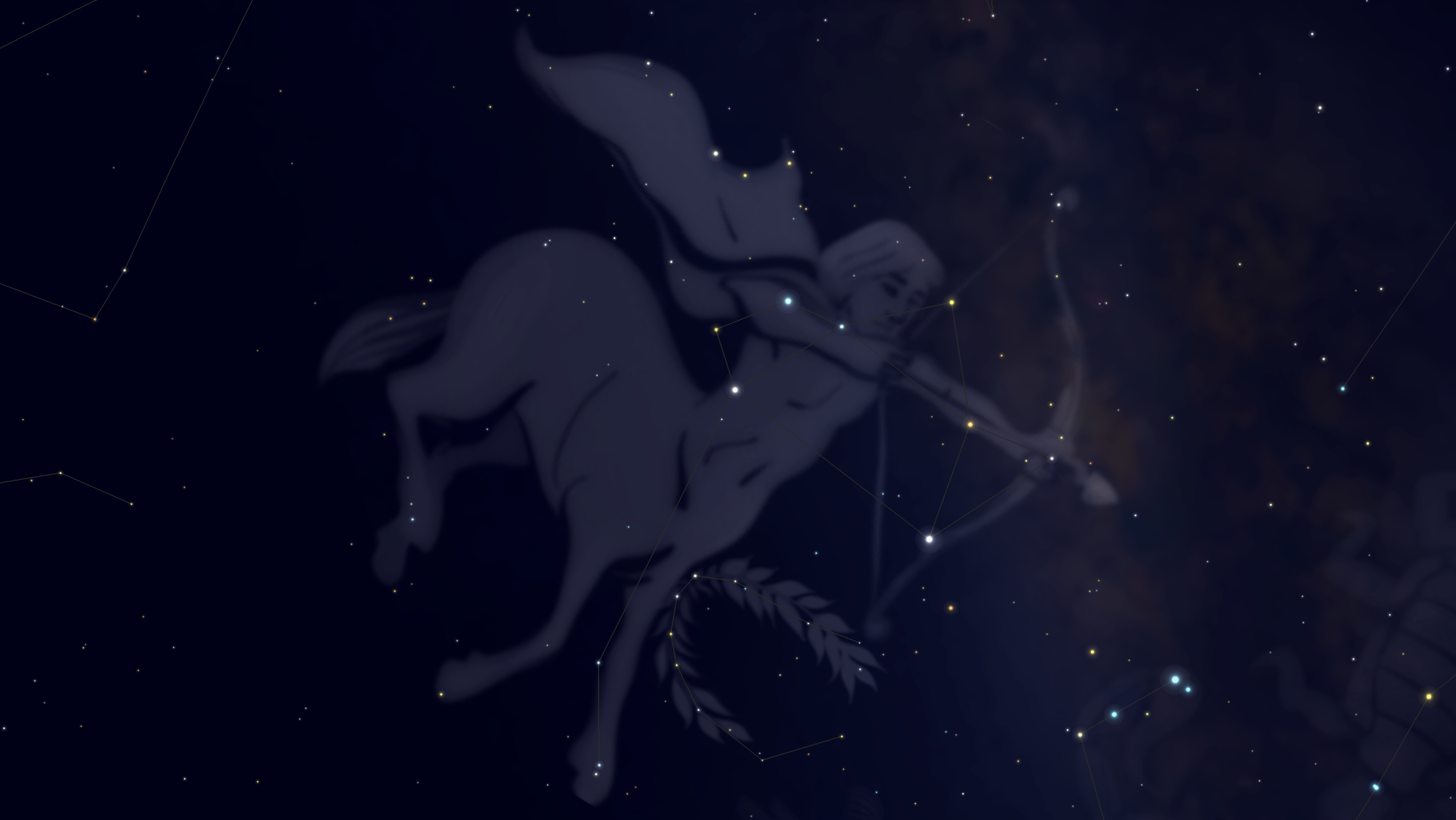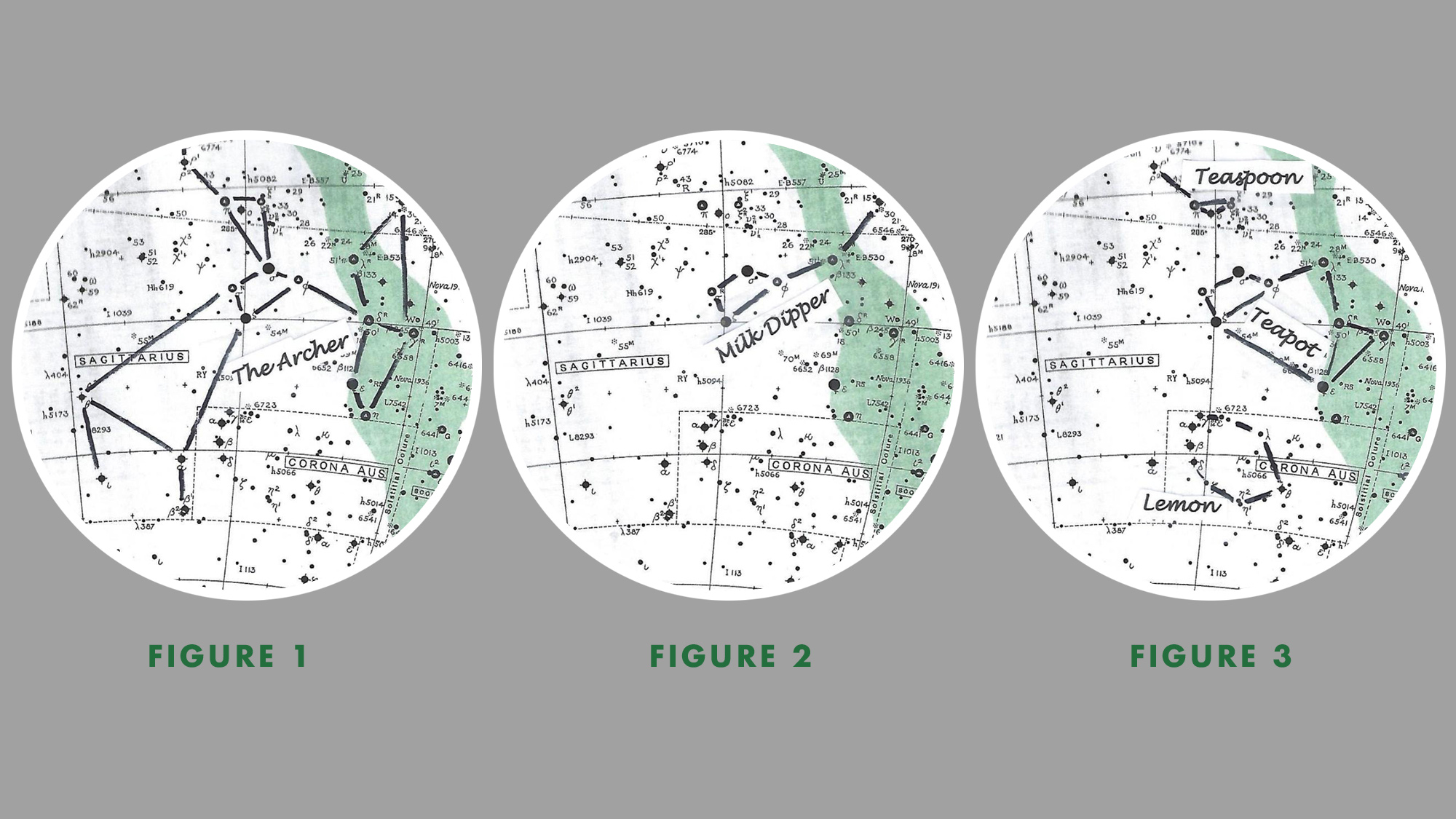Sagittarius Carries a 'Milk Dipper' and 'Teapot' into the Summer Sky

If you have ever seen a sketch or drawing where one moment you see something and then in another moment you see something completely different, that might best describe the zodiacal constellation of Sagittarius, the Archer.
Here among these stars, which observers in the Northern Hemisphere can see this week as darkness falls, about one-quarter of the way up above the south-southeast horizon, we can use our imagination to readily see a few different patterns, one of which resembles a bow and arrow.
Secondly, we can look at these same stars a bit differently to see a configuration resembling a dipper. Finally, we might see a device not familiar in antiquity, but likely found in practically every household kitchen: a teapot.
Related: Constellation Sagittarius: Archer, Dipper or Teapot?
It is interesting that two of the 88 constellations in the sky are represented by centaurs, a creature that never existed on Earth: Sagittarius in the zodiac and Centaurus near the South Pole. There is an interesting story that supposedly connects these two creatures, who both share the oddity of possessing the head, arms and torso of a man and the body and legs of a horse.
He was the "centaur of attention"
In mythology, the wisest and kindest of all centaurs was Chiron. He supposedly created the constellations, tracing out their outlines on the sphere of the sky. Prior to this, the stars were merely scattered across the sky and no one knew what they meant or how to use them. But Chiron devised what shapes in the sky were to be seen and then divided them into orderly groups.
In honor of his own contributions in the field of uranography (the mapping of the heavens), Chiron made one figure in his own likeness, and that was Sagittarius.
Breaking space news, the latest updates on rocket launches, skywatching events and more!
Chiron was also a mentor and educated many of the famous ancient heroes, such as Jason of the Golden Fleece, Achilles, Aesculapius and Hercules. But unfortunately, Hercules accidentally wounded Chiron using an arrow that had been dipped in the fatal venom of the multiheaded Hydra, the snake. Since Chiron was immortal, he could not die, but neither could he expel the serpent's poison and as such writhed in great agony. He finally cried out to Zeus to release him from his suffering and let him die. Zeus granted Chiron his wish and intended to place the wise and much-beloved centaur among the stars. Yet ironically, Chiron had been so efficient in his placement of the constellations, carefully allocating the number of stars for each, that there was no place for him . . . except for a spot in the far-southern part of the sky, where we now find the "other celestial centaur" known as Centaurus.
But while Chiron was a kindly soul, the centaur he created in his own image, Sagittarius, was quite the opposite in terms of character. Rather, he was pictured as a fierce individual, with his bow and arrow aimed directly at Scorpius, the Scorpion, who was responsible for stinging to death Orion, the Hunter. The Scorpion and the Hunter are on opposite sides of the sky, and in case the Scorpion has any ideas of scurrying over to try and sting Orion again, Sagittarius stands guard over him. On the opposite side of the sky from Sagittarius is Taurus, the Bull, who ducks out of sight beyond the northwest horizon as soon as Sagittarius begins to rise in the southeast — a circumstance that may have given rise to the branding of centaurs as bull killers.
Different strokes for different folks
As we suggested at the beginning of this essay, Sagittarius can be looked upon in a few different ways.
First, we can visualize him as what he is supposed to be: an archer.
H.A. Rey, who wrote two classic astronomy guides, "Find the Constellations," and "The Stars: A New Way to See Them" (both published by Houghton Mifflin in Boston), draws Sagittarius as a standing archer — not a centaur (Figure 1). But his version is still quite convincing: A man in a long skirt, with a feather on his head, leaning forward and aiming a bow at Scorpius, "apparently," noted Rey, "with intent to kill — perhaps to avenge Orion's death." In Latin, sagitta means "arrow." Rey's bow is a good enough bow. The Archer is supposed to be shooting his arrow at the Scorpion's heart (the bright red star Antares), but his aim appears to be a bit too low.
We can also visualize Sagittarius as an inanimate object: a "Milk Dipper," presumably used to dip up into the Milky Way (Figure 2). In fact, this inverted dipper is brighter and more readily visualized compared with the much dimmer yet more famous Little Dipper.
Because Sagittarius is located within the Milky Way in the direction of the "hub" or central bulge of our galaxy, it is here that the band of the Milky Way is at its brightest, although cut by dark bands of interstellar dust. This region of the sky is a veritable treasure trove for "sweeping" with good binoculars: It's spangled with galactic and globular clusters, plus nebulas (luminous clouds of gas and dust). Some of the clusters are visible to the naked eye as misty patches on a clear, dark night. Binoculars will not reveal the individual stars in these clusters but will identify the objects more easily.
Finally, you can look for one of the most amazing sky pictures we have: the Teapot.
We happen to be placed at just the right spot in our galaxy at just the right moment in time to witness eight fairly conspicuous stars forming a very good picture of an object that is familiar to us all. I used to believe that the creator of this pattern of stars was Henry Neely, a lecturer at New York's Hayden Planetarium in the 1940s and '50s. But I've since found references to the Teapot in star books dating back to the late 1930s.
But George Lovi, who authored the "Ramblings Through the Skies" column in Sky & Telescope magazine during the 1970s and '80s, used some of the fainter, neighboring stars to create a tea service. Poised above the Teapot's lid is the Teaspoon.
And below the Teapot, the constellation of Corona Australis (the Southern Crown) becomes a Lemon (Figure 3), while the star clouds of the Milky Way seem to mimic puffs of steam emanating upward from the spout of the Teapot.
Incidentally, the planet Saturn, shining sedately like a yellowish star, can currently be found sitting next to Lovi's Teaspoon.
- Best Night Sky Events of August 2019 (Stargazing Maps)
- Vibrant Star Cluster Sparkles in Sagittarius Constellation (Video)
- The Brilliant Stars of Sagittarius Glitter for Hubble Telescope
Joe Rao serves as an instructor and guest lecturer at New York's Hayden Planetarium. He writes about astronomy for Natural History magazine, the Farmers' Almanac and other publications, and he is also an on-camera meteorologist for Verizon FiOS1 News in New York's lower Hudson Valley. Follow us on Twitter @Spacedotcom and on Facebook.

Joe Rao is Space.com's skywatching columnist, as well as a veteran meteorologist and eclipse chaser who also serves as an instructor and guest lecturer at New York's Hayden Planetarium. He writes about astronomy for Natural History magazine, Sky & Telescope and other publications. Joe is an 8-time Emmy-nominated meteorologist who served the Putnam Valley region of New York for over 21 years. You can find him on Twitter and YouTube tracking lunar and solar eclipses, meteor showers and more. To find out Joe's latest project, visit him on Twitter.



